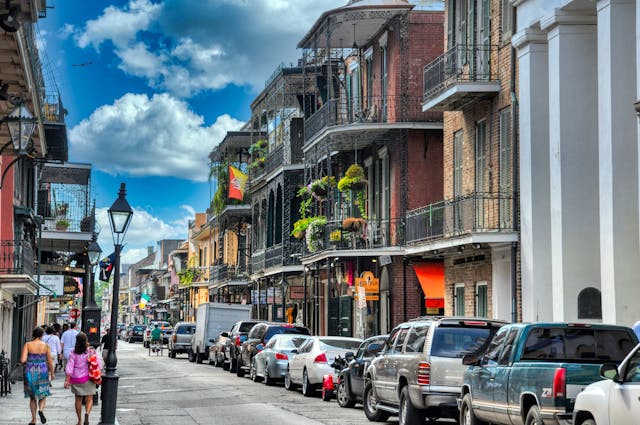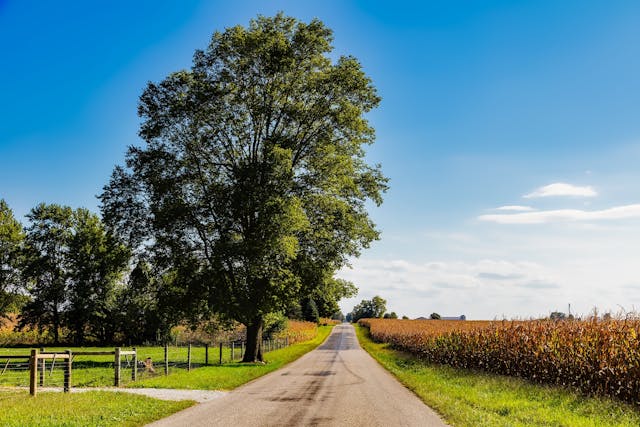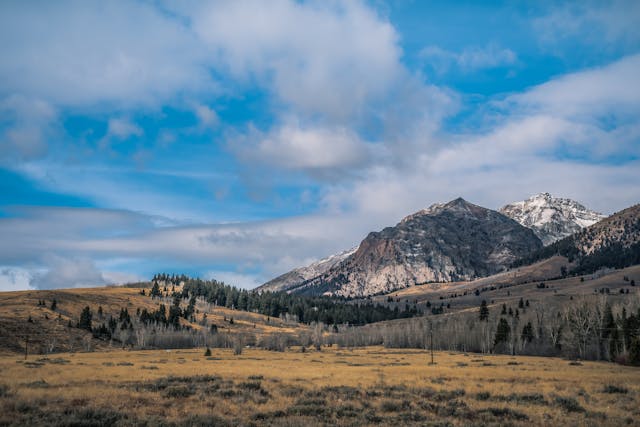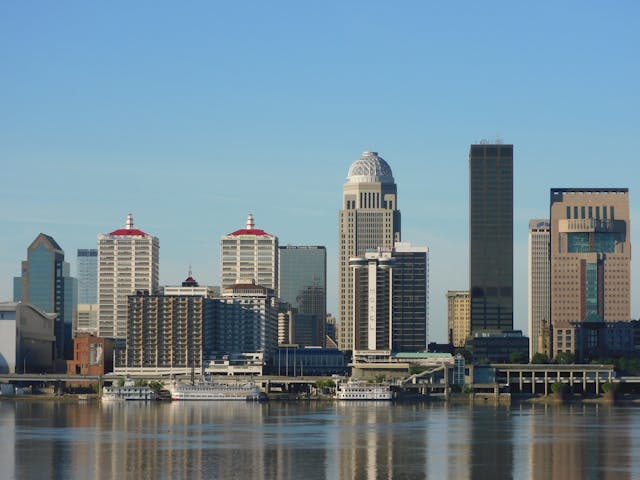Table of contents
More than half of Americans live in states most at risk if a recession hits in 2025. Fifty-eight percent of the population lives in one of the 25 states most vulnerable to a recession, placing millions in a tough spot if the economy turns.
With the market increasingly gripped by uncertainty in 2025, NationalBusinessCapital.com released its second recession-focused report, “The Least (and Most) Likely States to Survive a Recession in 2025.” With a few notable exceptions, the report shows that Americans living in more populous states are now bearing the brunt after years of high inflation and, over the past year, rising unemployment.
The report found 15 of the 25 most populous states finished in the bottom 50%. This means a recession could hit harder, exposing more people to job losses and rising living costs. Five of those states: Arizona (44th), Indiana (46th), South Carolina (47th), and Colorado (41st) finished in the bottom 10, with California (34th) and Florida (37th) narrowly avoiding it. The majority of the weakest states were located in the South or Mountain regions of the country, regions that saw housing and migration booms in recent years that drove up prices and strained household budgets. These booms specifically affected longtime residents with lower incomes.
On the flip side, the most resilient states included the northern Great Plains region, which performed quite well for the second time in a row. North Dakota (1st), Nebraska (3rd), South Dakota (8th), and Minnesota (9th) retained their hold on the top 10 from our 2023 recession report. Northeastern states, led by New York (2nd) and Delaware (6th), were among the most improved as they finally appear to be emerging from their COVID-era slump. Many states in this region saw either relatively small increases in their unemployment rate or even small decreases, suggesting a return to normalcy.
Key Findings
- Most Americans Live In A State Vulnerable To Recession. 58.1% of Americans live in a state ranked 26th or lower for recession readiness, which could bode poorly for the country should a recession materialize in 2025. Of the 25 most populous states, just 10 managed to rank 25th or higher. Notable outliers include New York (2nd) and Texas (10th), which had relatively strong government reserves, manageable household debt, and decreasing unemployment.
- Mountain and Southern States Are Most Vulnerable. Two geographic regions dominate 2024’s most vulnerable list, each taking four slots in the top 10: Mountain states Idaho (43rd), Arizona (44th, tied), Nevada (44th, tied), and Colorado (49th) and Southern states Kentucky (41st), South Carolina (47th), Mississippi (48th), and Louisiana (50th). These 10 states had higher-than-average unemployment at the beginning of 2025, with the rate increasing year-over-year in all save Arizona. Household debt was also a major issue in 60% of the bottom 10, with incomes failing to keep up with rising costs.
- Northern Great Plains States Remain Most Stable. North Dakota (1st) tops our list as the most recession-resistant state for a second time, thanks to a combination of high GDP relative to population size, ample government reserves, low unemployment, lower cost of living, and decent safety net coverage. It’s joined by Nebraska (3rd), South Dakota (8th), and Minnesota (9th).
- Unemployment Is Up Year-Over-Year In Most States. The unemployment rate nationally increased by an average of 0.3 points between February 2024 and February 2025. Just 10 states saw decreasing unemployment during that time.
- Debt Is Increasingly Straining Household Budgets. Household debt-to-income ratio increased from an average of 0.80 to 0.84 between 2022 and 2024, leaving American households more vulnerable to spiralling debt should they lose their incomes. During that time, household debt increased from 1.05 to 1.1 in Colorado, the state with the most household debt, and in Kansas, the state with the least, from 0.57 to 0.69.
Methodology
To create our rankings, we selected eight metrics to understand each state’s recession performance. Within each metric, the lowest-scoring state was given a rank of 0, while the highest-scoring state was given a rank of 100. Each metric was normalized and multiplied by a selected weight, then added together to create an overall score for each state.
Here are the nine metrics we chose, along with the percentage used to calculate the weight of each metric:
Government reserve balances (14%): This metric represents the percentage of the state government’s monetary reserves relative to that state’s government spending. For example, if a state’s government reserves are 32%, that means it saved funds equal to 32% of its spending in 2024. States with higher reserves can respond better to a loss of revenue and other economic shocks. Data was sourced from the Pew Charitable Trusts.
State GDP per capita (10%): This metric represents the per capita gross domestic product of each state. It represents the strength of the state’s economic output relative to its population size. Richer states are likely to have more resources with which to respond to economic disruptions, all else being equal. Data was sourced from the Bureau of Economic Analysis Gross Domestic Product by State 4th Quarter and Preliminary 2024 report and the Census Bureau’s 2024 state population estimates.
Debt-to-income ratio (14%): This metric represents the ratio of household debt within the state relative to the median household income of that state. Households with less debt tend to be more resilient when facing loss of income. Calculated using data from the Federal Reserve Bank of New York and the Census Bureau’s American Community Survey.
Unemployment insurance coverage (14%): This metric is the percentage of unemployed people covered by the state’s unemployment insurance programs in Q4 of 2024 - a measure of the current effectiveness of the state’s safety net. Data was sourced from the US Department of Labor.
Unemployment rate (10%): Each state’s preliminary unemployment data for February 2025 is included to gauge the current health of its economy. Data was sourced from the Bureau of Labor Statistics’ Local Area Unemployment Statistics.
Change in unemployment rate (10%): This metric represents the change in each state’s unemployment rate between February 2024 and February 2025 and is used to gauge whether the state’s economic condition is improving or worsening. Data was sourced from the Bureau of Labor Statistics’ Local Area Unemployment Statistics.
Housing unaffordability (10%): This metric represents the percentage of households that can currently cannot afford a new home built within that state, a measure of that state’s cost of living relative to its income. Data comes from the National Association of Home Builders.
Effective tax burden (8%): This metric is the aggregate weight of personal income, sales, property, and sales and excise taxes as a percentage of total personal income in the state, as calculated by WalletHub’s Tax Burden by State report.
Recent recession performance (10%): To get a sense of how states have fared under recession pressure, we looked at GDP changes in the aftermath of the Great Recession (Q4 of 2007 to Q4 of 2010) and the COVID-19 recession (Q1 to Q2 of 2020). Data was sourced from the Bureau of Economic Analysis’s historical GDP by State data.
The 10 States Most Vulnerable In A 2025 Recession

50. Louisiana
Score (out of 100): 30.8
Previous rank: 45th (-5)
Louisiana had a rough time in our last recession report, and the picture’s only gotten worse since then. The Pelican State’s budget is looking rough, having banked only 8.6% of spending in government reserves (50th) in 2024. That spending isn’t going towards much of a safety net either, with just 11.7% of the state’s unemployed populace covered by UI (47th). Making matters worse, unemployment is already higher than in most states (4.4%, 36th). Whereas some poor states like West Virginia and Mississippi are insulated from high prices, Louisiana ($71,292 per capita GDP, 37th) has no such luck, with new homes unaffordable to 85.4% of the population (40th).
Is there a chance the Bayou State could beat the odds? Perhaps! Louisiana weathered the Great Recession (+7.1%, 4th) better than most other states, though not the more recent COVID dip (-10.4%, 40th).

49. Colorado
Score: 31.6
Previous rank: 35th (-14)
The Constitution State saw the fourth biggest drop in ranking since our 2023 report. Why? Colorado’s households, already underwater, have sunk deeper with an average debt-to-income ratio of 1.1 (50th), leaving them extraordinarily vulnerable to any systemic shock that could come along in 2025. Unfortunately, there’s cause for alarm as Colorado’s unemployment rate is one of the highest in the nation (4.7%, 41st) and most rapidly growing (+1.2%, 48th).
Colorado is still among the richest states ($92,878 GDP per capita, 9th), but will the government come to the rescue? With government reserves equal to just 10.7% of spending (46th) and a UI safety net that covers just 20.1% of the unemployed population (30th), odds don’t look great for a soft landing in the Rockies.

48. Mississippi
Score: 31.8
Previous rank: 49th (+1)
Mississippi, the poorest state in the nation ($53,513, 50th) tends to have a rough time in these rankings, but it actually climbed one spot since our 2023 report. A big part of that is that it’s one of the only states in the country that doesn’t have obscene housing prices (67.6% of the population can’t afford a new home, 2nd) and only moderate household debt (0.81 ratio, 25th).
Still, the Magnolia State faces an uphill battle in a recession, with very limited unemployment coverage (14%, 44th) and joblessness starting to trend sharply upward (+0.7%, 40th). Past performance (39th overall) also provides little comfort, with the state taking it on the chin in both the Great Recession (-2.9% GDP, 41st) and COVID panic (-8.7%, 29th).

47. South Carolina
Score: 32.1
Previous rank: 44th (-3)
South Carolina has had a pretty good run over the last few years and is one of the fastest-growing states in the nation, even if it still ranks among its poorest ($63,876 per capita GDP, 45th). However, the environment that nurtured this boom may not be as well-suited for a bust cycle. South Carolina is seeing one of the highest year-over-year increases in unemployment (+1.1%, 47th), and while the unemployment rate isn’t too high (4.2%, 32nd), the state’s safety net covers a meager 12.3% of the unemployed (46th).
The Palmetto State did, however, save 44.1% in government reserves relative to spending in 2024 (11th), all with a fairly low effective tax burden (8.2%, 15th).

46. Indiana
Score: 34.7
Previous rank: 9th (-37)
No state saw a more dramatic shift–in either direction–from our 2023 report than Indiana, which fell a staggering 37 places from the top 10. So what exactly happened? Job creation in the Hoosier State has lagged behind most of the country in 2024, with unemployment rising 0.8% (42nd) to 4.3% (33rd), a trend partially attributed to Indiana’s higher-paying manufacturing industries being particularly susceptible to automation. The state is also stashing away far less money in government reserves (11.6%, 43rd), hampering its ability to respond during a rainy day. Not a great sign when unemployment coverage is already down to just 16.7% of the out-of-work populace (37th).
The one lone bright spot for Indiana this year comes in the form of its household debt-to-income ratio, which came in at a relatively low 0.75 (14th).

45. Nevada
Score: 35.4 (tied)
Previous rank: 43rd (-1)
Tourism-dependent Nevada tends to be a canary in the coal mine when it comes to economic downturns, having taken the worst hit of any state in both the COVID recession (-15.8% GDP, 50th) and Great Recession (-10% GDP, 50th), placing it dead last in recent recession performance. Worryingly, it also currently has the highest unemployment rate in the nation at 5.8% (50th), growing 0.6% year-over-year (37th). Household debt burden (1.03, 49th) is second only to Colorado’s, leaving Nevadans extremely vulnerable should they lose income or face unforeseen expenses.
While it may be harder to hold onto your job in Nevada, the state is at least doing a better job than most of covering its unemployed populace (27.3%, 20th) and stashing away money for a rainy day (41.5% government reserves, 12th).

44. Arizona
Score: 35.4 (tied)
Previous rank: 50 (+6)
The most improved of the bottom 10, Arizona climbs six spaces out of 2023’s dead-last finish into a tie with neighboring Nevada. While its household debt situation isn’t quite as dire as Nevada's or Colorado’s, it is approaching a worrisome 1:1 ratio with income (0.97, 43rd). The Grand Canyon State’s unemployment rate is higher than most states (4%, 30th), and its support of that population is subpar (16.6% covered, 35th). Arizonians shouldn’t count on the state to come to the rescue in an economic storm either, as it’s only saving government reserves equal to around 12.3% of its spending (42nd). Evaluating its recent recession performance (41st overall) is tricky, however, with Arizona having weathered the COVID dip (-5.2%, 4th) substantially better than the long financial crisis that began in 2008 (-7.2%, 48th).
On the positive side, Arizona’s unemployment rate did decrease by 0.1% over the past year (10th).

43. Idaho
Score: 35.8
Previous rank: 37th (-6)
Boise became something of a boomtown during the COVID pandemic. While the market’s cooled since then, real estate prices have left 85.7% of Idahoans unable to afford a new home (41st) and severely debt-burdened (0.99 ratio to earnings, 46th). Despite recent growth, the heavily agricultural state does have one of the smaller economies in the union ($64,014 GDP per capita, 44th) which, along with its rather stingy UI coverage (16.6%, 35th), could constrain its ability to respond to a serious crisis, as was the case with its slow crawl back from the Great Recession (-1.6% GDP, 33rd).
For now, Idahoans may want to capitalize on their relatively low unemployment rate (3.7%, 22nd) and low effective tax burden (7.5%, 10th) to stow away some cash for a rainy day.

42. Rhode Island
Score: 36.3
Previous rank: 38th (-4)
The lone Northeastern state to fall into the bottom 10 and the second poorest ($74,164 GDP per capita, 33rd), Rhode Island has been burdened by both high costs (84% can’t afford a new home, 38th; 10.1% effective tax burden, 43rd) and slow growth in recent years. Unemployment is higher than most states (4.7%, 41st) and has been rising (+0.8% YoY, 43rd). At the same time, the Ocean State has been struggling to put much cash away (10.7% government reserves, 45th), which could bode poorly for state programs.
That said, Rhode Island does compare favorably to most other states when it comes to covering its unemployed (36.5%, 10th).

41. Kentucky
Score: 36.5
Previous rank: 40 (-1)
Unemployment is rising in the Bluegrass State (+0.9%, 44th), joining just four other states with jobless rates over 5% (5.3%, 46th). Though this is attributed more to workforce growth than job losses, it could make jobs even harder to find should a recession trigger layoffs. Should that happen, Kentucky’s UI system doesn’t appear to be up to the task, with just 9% of its unemployed populace covered (49th).
The 10 Most Recession Ready States
1. North Dakota
Score (out of 100): 76
Previous rank: 1st (+0)
North Dakota retains its position as the most resilient state in the nation by a comfortable margin. The Peace Garden State had the best overall performance in the last two recessions (1st); despite seeing a sharp GDP drop during the COVID dip (-12%, 47th) it actually came out the other side of the Great Recession well in the green (+19.7%, 1st), bolstered by a booming oil industry. It currently enjoys the second-lowest unemployment rate in the country (2.6%). Unlike most states that seem to have to choose between strong safety nets and high taxes, North Dakota manages to have it both ways. Its effective tax burden is among the lowest in the nation (6.6%, 8th), matching its relatively high rate of unemployment coverage (36.8%, 8th), all while prudently managing its reserves (64.5% of spending, 2nd).
If there are any chinks in North Dakota’s recession armor, they’re related to housing pressure in its small but rapidly growing cities. New homes are unaffordable to 82.6% of the population (34th). And, while unemployment remains very low, it has been growing more rapidly here than in most other states (+0.6%, 38th).
2. New York
Score: 72.4
Previous rank: 17th (+15)
As has been the case in the past, reports of the Empire State’s impending demise may be greatly exaggerated. One of the states hit hardest by the pandemic and COVID-era policies, New York appears to finally be turning a corner with decreasing unemployment (-0.1%, 8th) and surprisingly affordable new housing (71.9% can’t afford a new home, 5th), at least relative to most other states. New York took a licking during the sharp-but-brief COVID recession (-8.9% GDP, 31st), but it came out of the Great Recession slightly better than it went in (+0.06%, 6th), leaving it in a respectable 7th place for overall recent recession performance. While New York is an expensive state to run, its reserves are on the high side (47.3% of spending, 9th), and its unemployed populace is relatively well-covered by UI (38.4%, 7th). It also ranks as the wealthiest state as measured by per capita GDP ($115,619).
Still, New Yorkers shouldn’t get too comfortable. While its unemployment picture is improving, its unemployment rate is still high relative to the national average (4.3%, 33rd), and its high tax burden could test strained budgets (13.6%, 49th).
3. Nebraska
Score: 72.3
Previous rank: 3rd (+0)
Nebraska retains its third-place ranking for the second year. While its economic base is quite different than North Dakota’s–featuring food production and insurance industries more than mining–it shares its characteristic Great Plains fiscal prudence and security. Unemployment is low in the Cornhusker State (3%, 5th), per capita GDP is high ($92,453, 10th), and government reserves rank among the highest in the nation (51.9%, 6th). Nebraskans also enjoy relatively low household debt relative to income (0.72, 7th) and a relatively low rate of housing unaffordability (73.1% can’t afford a new home, 8th). If recent performance is any indication, Nebraska should come through a recession in relatively good shape (6th).
What might go wrong? Like North Dakota, Nebraska’s unemployment rate is moving in the wrong direction (+0.5%, 32nd), and its unemployment coverage is on the low side (17.7%, 32nd).
4. Alaska
Score: 69.9
Previous rank: 2nd (-2)
Hunkering down in the Last Frontier and waiting for the recession to blow over may not be the worst idea. Alaska may have fallen a couple of spots since our last recession report due to relatively high unemployment (4.7%, 41st), but unlike many states, that number isn’t currently rising (+0%, 11th). Alaskans enjoy the lowest effective tax burden in the nation at 4.9%, high GDP per capita ($94,536, 8th), and one of the least distressed housing markets (70.4% can’t afford a new home, 3rd). Alaska took a beating during the brief COVID recession (-11.5% GDP, 45th), but actually did quite well during the Great Recession (+7.5% GDP, 3rd), putting it in a respectable 11th place for recent recession performance.
Like North Dakota, Alaska’s prospects in the theoretical 2025 recession will greatly depend on how well oil markets hold up. One potentially worrying sign is that Alaskan households are already fairly debt-burdened (0.88 ratio, 31st).
5. West Virginia
Score: 66.8
Previous rank: 10th (+5)
West Virginia climbs halfway up the top 10 list in 2025 to the number 5 slot. While much is rightly made of West Virginia’s economic woes, the Mountain State’s low cost of living has resulted in some of the least debt-burdened households in the nation (0.69 debt-to-income ratio, 2nd) at a time when household debt is rapidly rising. West Virginia’s state government is frugal, with reserves equal to 54.8% of its spending (4th). It’s also seen some of the best recent improvements in unemployment rate (-0.4%, 3rd), and its recent recession performance is decent (17th).
West Virginia’s main weakness is, of course, that it’s one of the poorest states in the nation ($60,826 GDP per capita, 49th), which can constrain its ability to respond to crises. Still, its unemployment coverage is above average (27.8%, 19th).
6. Delaware
Score: 66.5
Previous rank: 22 (+16)
Delaware earns recognition as the “most improved” state among our top 10 this year. The First State showed improvement since our 2023 report in a number of metrics, notably in terms of its government reserves (50.6%, 7th) and significantly better unemployment coverage (33.1%, 14th). The credit and LLC-incorporation hub remains among the wealthiest states per capita ($98,157, 6th) and features a low effective tax burden (6.5%, 6th). Delaware tends to hold up pretty well to recessions, having taken relatively minor hits in both the COVID recession (-4.8%, 2nd) and the 2008 financial crisis (-1%, 13th) for a 5th place finish overall in recent recession performance.
Delaware’s main weakness is its stubbornly high unemployment rate, at least compared to the rest of the country (5.4%, 47th), which is also trending in the wrong direction (+0.3%, 25th). Still, if you can hold on to your job there, Delaware may make for a good bunker.
7. Montana
Score: 66.2
Previous rank: 16th (+9)
Also showing significant improvement since 2023 is Montana, which climbed nine places into the top 10. Big Sky Country is doing a great job of covering (43.6%, 4th) its small unemployed populace (2.8%, 4th), with spending pretty well under control (46.4% government reserves, 10th). Impressively, Montana’s already low unemployment rate is improving (-0.6%, 2nd), a combination not seen in most other states right now. Taking the last two recessions into account, Montana held up fairly well, ranking 14th overall.
Montana’s biggest issues are its relatively small economy ($66,828 per capita GDP, 41st) and its high household debt-to-income ratio (0.90, 37th). New homes are also unaffordable to 81.8% of the population (33rd), likely a hangover from a spike in population growth during the COVID pandemic.
8. South Dakota
Score: 66
Previous rank: 8th (+0)
Holding onto its 8th place ranking is South Dakota. The Mount Rushmore State boasts the lowest unemployment rate in the nation (1.9%), with the rate even trending downward (-0.2%, 6th) thanks in part to a strong financial services sector. Its effective tax burden (6.5%, 5th) is even lower than its neighbor to the north, finishing second only to it in past recession performance (2nd). Households have a 0.75 debt-to-income ratio (15th).
As was the case in our 2023 report, however, South Dakota’s safety net is leaky, with only 19.3% of its unemployed population covered by UI (31st), and there could potentially be budget issues ahead (13.7% government reserves, 41st).
9. Minnesota
Score: 65.6
Previous rank: 5 (-4)
The North Star State tumbles a few spots in this report but manages to hold onto a place in the top 10. As was the case in our 2023 report, Minnesota does an excellent job of covering its unemployed population with UI (61.8%, 1st), all while turning in one of the lowest unemployment rates in the country (3%, 5th). Housing stress, too, is on the low side–at least relative to other states–with 74.4% of the population unable to afford a new home (10th). While it didn’t turn in a remarkable performance in either the Great Recession (+2.1% GDP, 15th) or COVID crisis (-8% GDP, 23rd) it still fared better than most states in both (15th overall).
So why did Minnesota lose some points this year? A big factor is declining government reserves (22.3% of spending, 32nd) and an uptick in household debt relative to income (0.81, 23rd), which suggests some mounting budget stress for both the state government and its citizens.
10. Texas
Score: 65.5
Previous rank: 14th (+4)
The only Sunbelt state to crack the top 10, Texas’s booming economy is likely to be more resilient in a recession than most of its regional peers. The Lone Star State’s budget is flush with cash (60.8% government reserves, 3rd), and its construction boom has led to more affordable housing (74.1% unable to afford new homes, 9th) than most of the country despite significant population growth. While Texas’s reputation for low taxes is somewhat overstated when you factor in more than personal income tax (7.8% effective tax burden, 11th), it still compares favorably to most states.
Like the other large state on the top 10 list, New York, Texas’s main weakness right now is its comparatively high unemployment rate (4.1%, 31st), which is moving in the wrong direction, albeit only slightly (+0.2%, 17th). Past recession performance is mixed (19th overall), with Texas having done better in the Great Recession (+2%, 17th) than the COVID dip (-8.9%, 32nd), suggesting some resilience to housing market stress and vulnerability to supply chain shocks.






